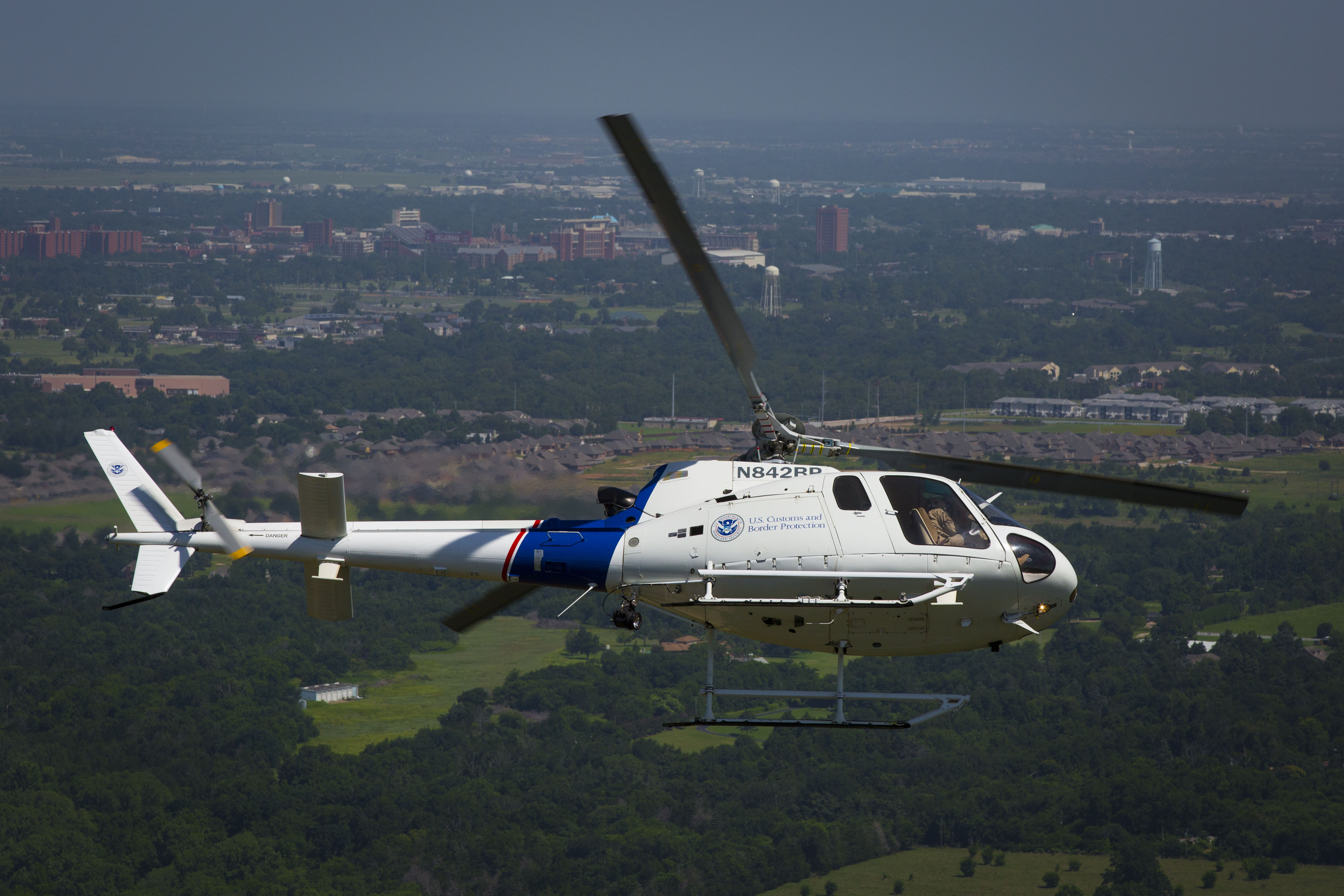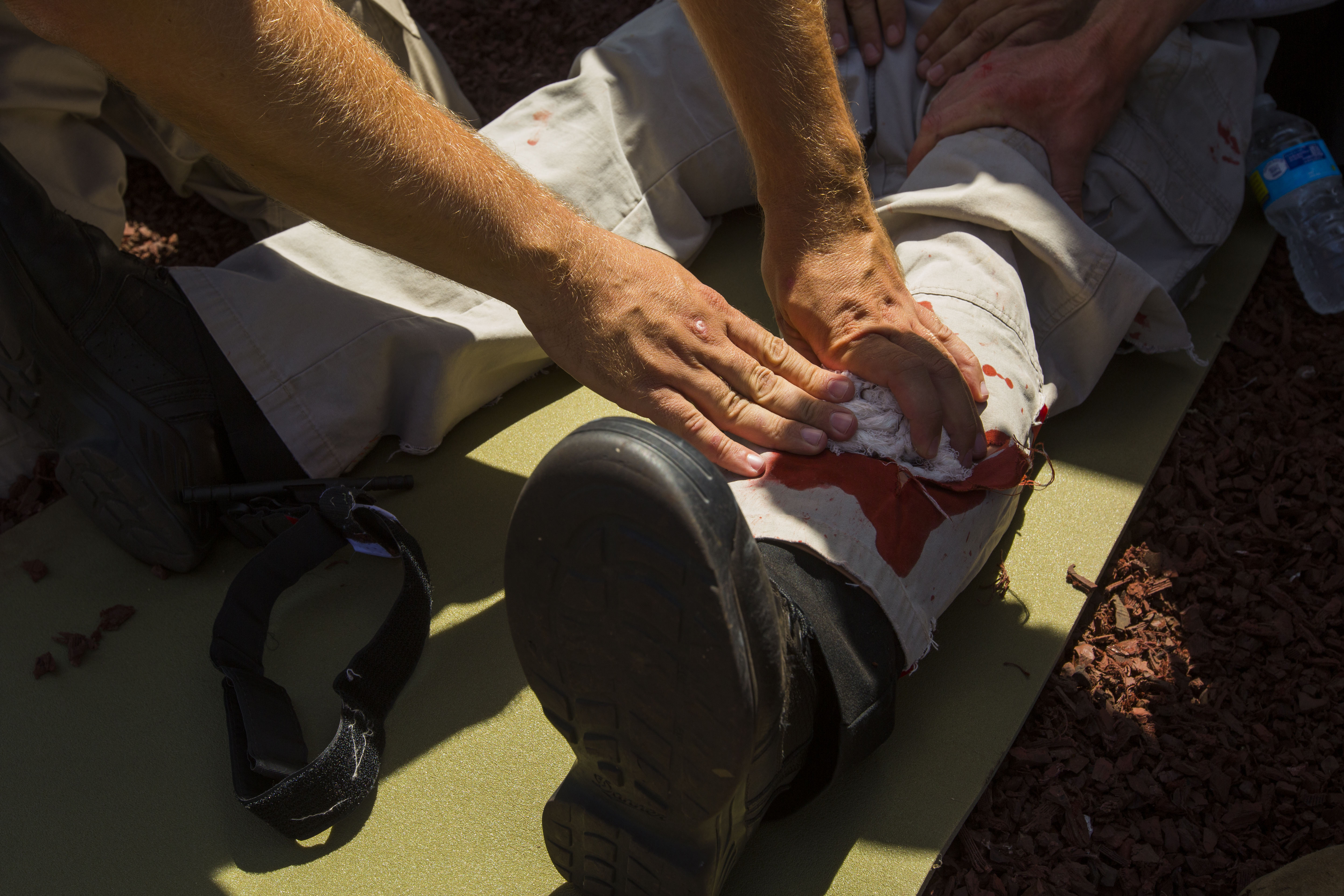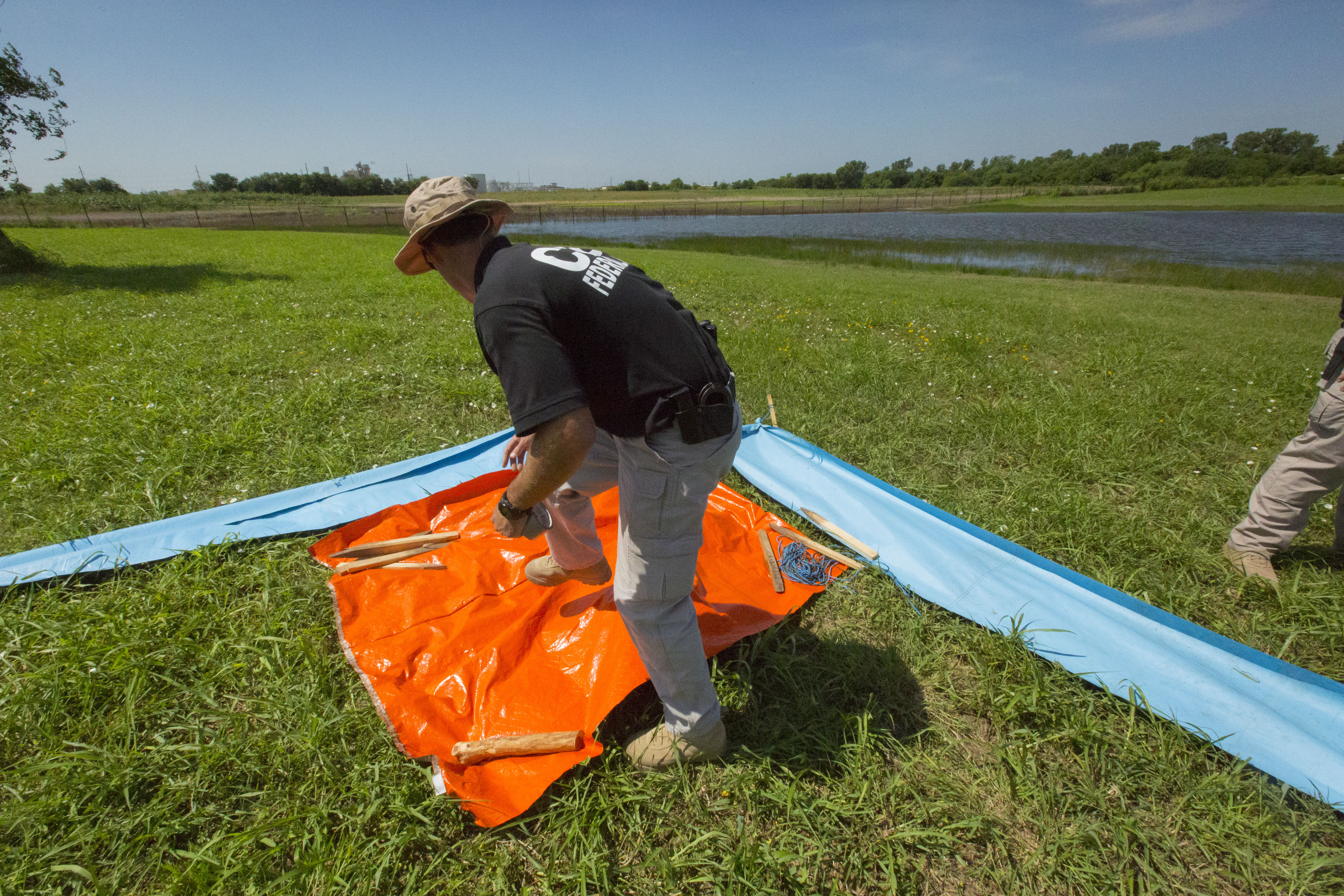
Skills to Survive
After departing a lonely airport near the U.S. southern border, the Cessna 172 steers to Nebraska. It flies low and long. The small plane makes two stops along the way, but only at desolate airports.
That profile is typical of drug-running aircraft, but just as typical of how pleasure pilots fly. When the Cessna reaches its destination, U.S. Customs and Border Protection Air and Marine agents may question the pilot and search the aircraft to see if their suspicions are correct.
Training to handle those encounters safely and professionally is provided at CBP’s National Air Training Center in Oklahoma City. The center is where new aviators learn the tactics and procedures that will shape their careers and where seasoned flyers return to keep those skills sharp.

Training the largest law enforcement air force
With more than 650 pilots, CBP’s Air and Marine Operations keeps the center busy. Aviators come to the center each year for three days of intense one-on-one refresher training in helicopters or fixed wing aircraft. Survival, ground tactics and sensor operator training is also offered. Center staff conduct interviews and flight evaluations for new pilot positions as well.
The center is really two buildings. There’s a main building with classrooms, conference and planning rooms and administrative offices, nicknamed “The Castle” for its two turret-like structures, and a 67,500 square-foot hangar. The hangar holds the center’s nine aircraft, maintenance facility, multimedia training center and briefing rooms.
The center’s mission is to strengthen and standardize procedures, and that improves proficiency and safety, said Tom Salter, the center’s director.
“Standardization is the key point we drive home here,” he said.
Something just broke
Standardization begins when pilots arrive for recurrent training. They review aircraft systems such as hydraulics, electrical and fuel. They revisit flight performance, weight and balance, and maneuvers. What’s reviewed on the ground is later applied in the air.
Pilots also get to practice emergency scenarios not authorized at their duty stations to stay current with those tasks. “Some of these maneuvers are higher risk,” explained instructor John-Paul Ayubi. “That’s why we limit who can do them.”
For instance, a helicopter governor failure. The governor is a mechanical device that maintains a set engine speed by controlling fuel flow. The governor is directed by a computer.
In the simulation, the instructor disconnects the computer, requiring the pilot to manually control the fuel flow with the throttle to maintain the proper rotor blade speed. If the speed gets too low, the rotor won’t generate enough lift to keep the helicopter airborne. If the speed gets too high, the centrifugal force can rip the blades from the helicopter.
Without the computer, the throttle also loses its precision and “becomes very touchy,” as Ayubi described it.
The throttle is a rotating cylinder attached to the end of the left-hand control stick, called a collective. Moving the stick up or down changes the pitch of the rotor blades. Stick up, helicopter climbs. Stick down, helicopter descends. Turning the cylinder increases or decreases fuel flow and that controls rotor speed.
With a broken computer, the pilot transitions from one movement with the left hand that automatically controls fuel and pitch, to two movements with the left hand to adjust fuel and pitch. “It’s a kinesthetic challenge,” said Ayubi.

Autorotation is another maneuver. The instructor brings the power to idle, simulating a failed engine. The aircraft descends, but the upward rushing air keeps the rotors spinning, allowing the aircraft to descend in a controllable glide. As the helicopter nears the ground, the pilot then trades the speed of the rotors for lift by increasing the angle of the blades, affording the pilot a safe landing, according to Ayubi.
While everyone gets the same curriculum, it’s not rigid. There’s time to focus on weaknesses and even options to add extra training days if needed. “It’s standard, but flexible,” he said.
Not all training is in the sky. Land and water survival, police tactics, pilot certificate inspections and first aid are provided in a five-day reality-based package. Air and Marine Operations agents take this refresher course every five years.
When practicing police tactics, participants use pistols that fire plastic bullets containing paint. Since the bullets can bruise at close range, agents and instructors wear masks and other protective garments. Using non-lethal bullets rather than blanks creates more stress and realism.
Be polite, but cautious
Instructors emphasize treating citizens with respect, but never letting your guard down.
Take pilot certificate inspections. During his training, Chad Smith, an air interdiction agent with 19-years of law enforcement experience, approached the pilot, played by a municipal SWAT (special weapons and tactics) officer. The pilot is standing next to a static Cessna aircraft.
Observing Smith is instructor Mike Tully and James Wilson, an attorney and instructor. Their critique helps agents perfect their skills for approaching an aircraft.
“How are you today?” said Smith, walking toward the aircraft. “Great day to be flying, isn’t it?”
Smith asks to see the pilot and medical certificates. The pilot asks why. He hesitates. He resists Smith’s disarming demeanor, but hands the documents to Smith.
Smith then asks to inspect the aircraft’s registration and airworthiness certificates, usually stored in a plastic sleeve near the floor by the pilot’s seat.
“Could you please move back to the tail?” Smith first asked, striving to keep a safe distance from the pilot. The pilot grants permission for Smith to inspect inside the aircraft.
Smith reviews the documents, finds them satisfactory and the inspection is complete.
Tully and Wilson then debriefed Smith on the legal and tactical considerations during pilot certificate inspections. Tully suggested Smith could have improved his safety by standing diagonally from the pilot when the documents are handed to him, known as a bladed stance.
They explained, for instance, that holding a conversation with the pilot not only helps build rapport, but could reveal a higher level of suspicion to search further. “Just remember,” Tully concluded, “you’re still a cop. You’re going to be polite, but you’re going home safely.”
There’s also a crash scenario, complete with frantic cries for help and police actors who simulated serious injuries. Agents reviewed how to assess injuries and stabilize the victim. “What are we looking to do?” instructor Craig Ilschner coached one group as they readied a tourniquet. Each victim presented a different calamity.
All wet and upside down
Surviving at sea is a day in the pool.
“A helicopter crash in the drink is serious,” instructor Chad Warren told several agents about to get wet. “Water fills in quickly and the aircraft sinks like a rock.”
They’re about to find out how.
Agents strapped themselves into a seat mounted on a floating framework that resembles an aircraft cockpit. The device is flipped over, simulating an aircraft sinking inverted. While inverted, the agent must calmly reach for the mouthpiece on the survival jacket that’s connected to an air bottle, purge the water from the mouthpiece and breathe the compressed air. Then the agent unstraps from the seat, opens the door, swims from the dunker and surfaces.
To recognize up or down while inverted, agents learn to locate a reference point on the dunker. “Hang on to your reference point,” urged Warren. “Never let go.”
“It’s going to be uncomfortable,” he warned. “Water may be going into your nose, but at least you’ll be breathing.”
Before taking the dip, agents practiced using their lifesaving air bottles. About the size of an aerosol can, the air is packed at 3,000 pounds per square inch. Depending on how you breathe, the bottle can give a downed pilot anywhere from four to five minutes of time underwater.
Agents must dive underwater, fetch an air bottle placed on the bottom of the pool, purge the water from the mouthpiece and start breathing. “I don’t want to see your head above the surface until your bottle is empty,” said Warren. About half the group took multiple tries. A few came up coughing.

Water survival also covered how to stay warm, ways to produce fresh water and use a life raft.
“How can you stay afloat?” offered instructor Wade Plant. “Stuff plastic bottles into your flight suit or even blow air into your suit creating a bubble.” He explained how to use an array of survival gear from fishing line to flares to seasickness pills.
Seasickness pills are preventative. “Take them before you expect to get sick,” he said. “They don’t work after you get sick.”
We’re stranded
Moving from wet to dry, the land survival segment centered on an aircraft forced to make an emergency landing somewhere in the Arizona desert—in this case, some acreage with a pond and a few patches of woods. Agents were allowed to use the survival kits they were issued. About the size of a large wallet, the 98.6 survival kits, as they’re called, can fit into a flight suit pocket.
It’s amazing what can fit into that small pouch: a heavy-duty plastic shelter bag, cord with 200-pound strength, cutting tool, fire starter, whistle, light, mirror, water disinfection tablets, duct tape, lanyard, storage bag and an instruction booklet.
First task: signal the search teams. Lines and angles stand out against natural topography, instructor Ken Vitale pointed out. Fashioning a huge X or V using anything from sticks, stones and debris works well, he said.
The group fashioned a huge X, using strips of blue tarp held in place by pegs and cord. In an interesting procedure, they plucked grass, rolled it into small clumps and wrapped the corners and some edges of the tarp around the balls of turf. This formed a knob, called a button, providing a better grip for the cord.
“Remember this is your ticket home,” Vitale encouraged. “Make it big. Make it good.” Afterward, agents built shelters using plastic sheets, cord, duct tape and the knots they practiced in the classroom.
Fire was next. “Fire is extremely important,” said Vitale. “It purifies water and cooks food.” Taking the group into the woods, Vitale showed them how to properly collect fuel. He then stacked the wood, starting with brittle tinder, then adding heavier kindling and then thick sticks.
Vitale smacked a knife against a magnesium block. Sparks flew into the fibrous tinder, spiked by a cotton ball smeared in petroleum jelly taken from the 98.6 kit. Instantly, fingers of flame shot out.
“Light the bottom of the tinder,” he instructed. “Fire moves upward.”
“Fire is simple,” said Vitale. “But people have trouble because they skip stages—they want to go too big, too soon.”
Facing a terrorist
Perhaps the most intense training—and where standardization is really critical—is the active shooter scenarios.
The center uses a former junior high school and role players from a local municipal SWAT team who pose as crazed shooters. Air and Marine agents practice the same tactics taught to all law enforcement officers.

Standardization is key. “If you show up [at the shooting] it’s likely you will work with someone you’ve never met,” Warren advised the group. That means police from many jurisdictions will likely be converging on the building where a shooter is on the loose and they can only work together safely if they know what’s expected, he explained.
Tactics are designed to quickly locate and subdue a shooter while keeping responders safe. Agents review how to proceed through a building, what clues to look for, how to communicate as a team and how to identify and clear the occupants.
During the exercise, the agents raided the school three times, the third time in the dark. To make the event more realistic, a high-powered speaker blasted audio of confused and panicked crowds punctuated with screams and gunshots.
Aviation training in Oklahoma City began in 1987 when the U.S. Customs Service founded the Customs National Aviation Center. In 2005, the center became the National Air Training Center when Air and Marine operations merged with elements of the Border Patrol, continuing its mission of training and standardization with a growing cadre of law enforcement aviators.
Under Director Salter’s leadership, staff and instructors strive to provide training that enhances both an agent’s personal and professional life. And while agents learn the skills to perform their jobs safely and efficiently, it’s just as important that they’re pleased with the instruction, according to Salter.
“I consider this institution more than a training center,” he said. “I want agents to leave here satisfied that they got what they came here for. I want our agents to leave here with the confidence and skill to continue to train, develop and grow into world-class pilots.”


